Preprint
Article
Study of Bisphenol A Degradation Using Ultrasound and Aditional Chemical Compounds
Submitted:
08 August 2023
Posted:
09 August 2023
You are already at the latest version
A peer-reviewed article of this preprint also exists.
Abstract
Bisphenol-A (BPA) represents an important co-monomer for obtaining polycarbonate, epoxy resins, flame retardants, in paint, and other chemicals products. Products containing BPA are widely used, and thus, we can find it in the environment: in the air, in the soil, in natural surface water and in sediments, underground water in landfills, and in wastewater. BPA disturbs human and animals’ health. This influences the enzymatic, androgenic, neurological, liver and reproductive systems at different stages of human life: like in fetal stage, children and adults’ stages. Taking these inconveniences into account, it is very important to remove BPA from water. Ultrasonic technology can be considered a verry sustainable and efficient method to remove BPA from water. The advantages of this method is easy to implement on existing water treatment and purification facilities, it does not produce residual compounds that produce sludge, the time required for degradation is of the order of 1-2 hours and the level of degradation is very high. In this work, we presented the studies on the efficiency of ultrasonics under air atmosphere on the degradation of BPA. The influence of the frequency and of some additional compounds such as carbon tetrachloride, FeSO4 7H2O (FS), and ethyl anthraquinone (EAC) was studied. Three different frequencies were used: 1146 KHz, 864 KHz, 580 KHz, at a power of 50 W. It was identified the efficiency of BPA degradation over a period of 60 minutes, with sampling every 15 minutes. Using the LC-MS/MS technique, the degradation compounds were identified that result from the application of ultrasound processes. Pathways of BPA degradation were also proposed.
Keywords:
Subject:
Environmental and Earth Sciences - Pollution1. Introduction
Bisphenol-A (BPA) represents an important co-monomer for obtaining polycarbonate, epoxy resins, flame retardants, in paint and other chemicals products [1,2]. Products containing BPA are widely used, and thus, we can find it in the environment: in the air, in the soil, in natural surface water and sediments, underground water in landfills and in wastewater [2]. BPA disturbes human and animals health [3,4,5,6]. This influence the enzymatic, androgenic, neurological, liver and reproductive systems at different stages of human life: like in foetal stage, children and adults’ stages [7,8]. BPA causes disorders of the reproductive system in both women and men that can cause diseases such as infertility, abortions, polycystic ovaries, endometrial hyperplasia, etc. [9]. Taking these inconveniences into account, it is very important to remove BPA from water. Ultrasonic technology can be considered as a very sustainable and efficient method to remove BPA from water. The advantages of this method are: the method is easy to be implemented on existing water treatment and purification facilities, it does not produce residual compounds that produce sludge, the time required for degradation is of the order of 1-2 hours, and the level of degradation is very high [2,10]. Ultrasound (US) treatment of wastewater is considered an advanced oxidation process (AOP). Unlike other AOPs, ultrasound treatment does not require the addition of catalysts or oxidants [11]. Among the various AOPs, the sonochemical process is used for the degradation of organic pollutants, because of its eco-friendly properties and because it does not generate hazardous by-products during the cavitation process. Its efficiency depends on the hydrophobicity of the pollutants, and BPA is a hydrophobic compound, being suitable for US treatment [12].
The ultrasonic mechanism is mainly achieved by acoustic cavitation. It includes the formation of bubbles, the rapid growth and violent collapse of bubbles in the liquid. At this point, high temperatures and pressures rise to 5000 K and 100 Pa, are generated, fact which causes the decomposition of organic pollutants and water [2]. Through the decomposition of water molecules, highly reactive radical species as hydroxyl, hydrogen and hydroperoxide radicals are formed, which can oxidize the organic matrix [13], can destroy the molecular structure of pollutants, to achieve the degradation effect [14]. Organic pollutants are attacked by radicals with a high oxidation potential, forming compounds with lower molecular weight [15].
According to equations 1-5, the reactive radical species produced by the ultrasonic cavitation phenomenon are: [16].
H2O + US → •OH + H•
O2 + US → 2 O•
H• + O2 → •OOH
O• + H2O → 2 •OH
•OH + •OH → H2O2
H2O2 + US → 2 •OH
In addition to radicals, the implosion of collapsing bubbles generates strong pressure waves, which are used for physical and chemical processes in wastewater treatment [15]. The diversification of free radical species can be done, for example, by adding a sonocatalyst [14]. Previous studies against the use of US for wastewater treatment question the economic viability, based on energy consumption calculations [12]. The effect of US wastewater treatment is limited by the disadvantage of energy consumption [14]. The possibility and efficiency of US application for BPA degradation have been investigated in various studies, but most of the research have been carried out using the sonochemical process as an auxiliary technology, to assist the photocatalytic, Fenton, UV, electrochemical processes [12]. Combining the US process with peroxydisulfate provided a promising advanced oxidation method for the removal of organic pollutants from aqueous solutions [17].
An effective way to improve the US treatment method to increase the degradation rate and treatment efficiency is by combining it with materials with sonocatalytic activity. The principle of US treatment is based on the attack of free radicals on the pollutant to degrade it, while the input of active sonocatalytic materials can improve the generation and enrichment of free radical species, so that the degradation process is continuously enriched, in a natural way [14]. A Fenton-like catalyst used in combination with US technology for BPA degradation is Schwertmannite (Sch), an iron (III) oxyhyroxysulfate mineral. BPA degradation was significantly enhanced (98.0%), when the catalytic system was coupled with US (US/Sch/H2O2), indicating that there is a synergistic effect between US and Sch on H2O2 activation [16]. Due to the limited efficiency of BPA degradation by the single system with US or by oxidants without US assistance, the researchers investigated the activation of four different common oxidants by US. Following the analyses, they found that US and the investigated oxidants have a synergistic effect, obtaining the following synergy indices of the systems US-S2O82-, US-H2O2, US-HSO5,- and US-IO4- 1.13, 1.16, 1.25, 2.22 [13]. The study [16] indicates that the degradation reaction of BPA in the presence of US and Sch occurs in two stages, consisting of an induction period, followed by a rapid degradation period, according to a pseudo first-order kinetic process. The degradation efficiency was affected by several operating parameters, especially pH, catalyst dosage, temperature, H2O2 concentration. The optimum pH was 3, lower or higher values leading to decreased degradation efficiency. Increasing the dosage of Sch from 0.1 to 1 g/L was effective, but an increase to 2g/L did not lead to the improvement of the process, the increase in temperature led to the increase in the reaction rate in stage II, and the concentration of H2O2 was maximally effective at 15mM, lower values were not effective, and higher values inhibited degradation.
From previous research, it was found that ultrasonic degradation was effective at a higher frequency. Investigating the factors affecting the ultrasonic degradation rate of BPA [11], stated that dissolved oxygen, higher ultrasonic frequency in range 300-500 KHz is most efficiently [2], higher power favored BPA degradation, while the presence of HCO3-, HA prevented BPA degradation, and Cl- a showed a minor influence. Investigating the effect of operating parameters on BPA degradation efficiency, it was found [7] that degradation was stimulated by increasing ultrasound power (38.87-97.17W), temperature (30-70°C), and initial PDS concentration (peroxydisulfate) (1.71-17.11). Determining the significance of these operational parameters in BPA degradation, their importance was estimated in the following order: temperature 46.83%, initial PDS concentration 40.54%, ultrasound power 12.63%.
The researchers' studies demonstrate that US irradiation is a promising way to effectively treat BPA in aqueous solution under optimal operating conditions – US frequency, power intensity, addition of oxidants, impact of different additives, quickly and without negative side effects.
In this work, we presented the studies on the efficiency of ultrasonics under air atmosphere on the degradation of BPA. The influence of the frequency and of some additional compounds such as carbon tetrachloride, FeSO4 7H2O, and ethyl anthraquinone was studied. Three different frequencies were used: 1146 KHz, 864 KHz, 580 KHz, at a power of 50 W. It was identified the efficiency of BPA degradation over a period of 60 minutes, with sampling every 15 minutes.
Also, using the LC-MS/MS technique, there the degradation compounds that result from the application of ultrasound processes were identified. Pathways of BPA degradation were also proposed.
2. Materials and Methods
2.1. Chemicals and equipments
Chemical reagents used for experiments Bisphenol A (purity > 99.9 %),, ethanol (99%), carbon tetrachloride (purity > 99.9 %, CCl4,) ferous sulphate heptahidrated (FeSO4 7H2O), methanol (HPLC grade) and acetic acid, etil antrachinone, sulphuric acid were acquired by Sigma-Aldrich (Germany). All the rest of reagents used in the experiment were of analitique quality. High purity water was obtained in house, using an ultrapure water system, from Merk Millipore (Burlington, Massachusetts, US).
Ultrasonic system
A Meinhardt multifrequency ultrasound system composed of a frequency generator (580, 684 and 1146 kHz), a power applicator and an ultrasonic transducer was used. The metal reactor is connected to the transducer through a flange and is provided with a jacket through which coolant from a thermostat circulates. The system diagram is presented in Figure 1
2.2. Analytical methods used for BPA and intermediates resulted.
2.2.1. Analytical conditions used for BPA determination
The experiments for BPA quantification were carried out using Agilent 1260 series LC system (Agilent, Waldbronn, Germany) coupled with an Agilent 6410B triple-quadrupole mass spectrometer with electrospray ionization source (ESI). Luna C18 type (150 × 2.0 mm; 3.0-μm particle size) chromatographic column, maintained at 35°C was used. The mobile phase consisted of 0.01 % acetic acid in ultrapure water (A) and Methanol (B) 30/70 v/v, in isocratic mode, at a flow rate of 0.15 mL/min. The injection volume was 1 µL. BPA detection was performed in MRM (Multiple Reaction Monitoring) mode, monitoring two mass transitions: 227 → 212 and 227 → 133. MS parameters established for the BPA quantification were: cell accelerator voltage (1V), fragmentor voltage (150V), collision energy (15V), and dwell time (250msec). The BPA elution was performed in less than 6 min. ESI operational parameters: capillary voltage (6000V), drying gas temperature (300°C), drying gas flow (7 L/min) and nebulizer pressure (40 psi).
2.2.2. Analytical conditions used for the identification of the degradation products
Determination of unknown degradation products of BPA was executed using LC-MS/MS technique. The injection volume was 5 μL. The Luna C18 chromatographic column temperature was set at 20C°. The mobile phase consisted of 0.01% acetic acid in ultrapure water (A) and Methanol (B) 40/60 v/v, in isocratic mode, at a flow rate of 0.15 mL/min and a stop time of 15 min. Data were gathered in the enhanced mass spectra mode, between 50 and 350 Da. Full-scan chromatograms were registered, using the ESI source in negative mode. ESI operational parameters: capillary voltage (6000V), drying gas temperature (300°C), drying gas flow (7 L/min) and nebulizer pressure (40 psi).
2.2.3. Quality assurance and quality control
All samples were analyzed in duplicate. An etalon and a blank sample were injected at each test sequence. The method linearity was evaluated between 0.015 – 25 mg/L, using six calibration points (0.015, 0.01, 0.5, 5.0, 10 and 25 mg/L), high correlation coefficient value being obtained, R2 = 0.998. Recovery was not evaluated because sample preparation required only a dilution step. The RSD values for intra-day and inter-day precision were 3.2% and 5.7%, respectively. The method accuracy was 0.92%. Limit of detection (LOD) was 0.005 mg/L, and limit of quantitation (LOQ) was 0.015 mg/L, respectively. The measured uncertainty was determined to be 22.6%. Samples were diluted using ultra-purified water, to fit in the calibration domain. The degradation level of the BPA was determined using chemical oxygen demand analysis, COD according to the SR ISO 6060:19962.
2.4. Work Methods
Volumes as 100 mL of synthetic solution with 25 mg/L initial BPA concentration were introduced into the ultrasonic reactor under air atmosphere. The ultrasonic reactor was inserted into a cooling bath that maintains a relatively constant temperature in the range between 20 and 32⁰C. The influence of frequency and doses of some additional compounds such as: carbon tetrachloride, ferrous sulphate heptahydrate and ethyl anthraquinone on the efficiency of BPA degradation were studied. Three different frequencies were used: 1146 KHz, 864 KHz, 580 KHz, at a power of 50 W, in the absence and in the presence of additional compounds.
Carbon tetrachloride, CCl4 was used in three different initial doses: 6 µL, 12 µL and 25 µL to 100 mL initial solution. The degradation efficiency is studied for 864 KHz, 580 KHZ, at a power of 50 W, after 15 minutes of exposure. Another additional compound, FeSO4 7H2O, FS, with 0.1 mg/L concentration, was used in two doses: 5mL /95ml initial solution and 20 mL /80mL of initial solution. The variation of efficiencies of BPA degradation in time, for each 15 minutes, time of 60 minutes, at a frequency of 580 KHz was studied. In the end, the BPA degradation efficiency was studied for a time of 60 minutes at 580 KHz for Ethyl anthraquinone with doses of 0.1, 0.2, 0.3 mL/100 mL initial solution, respectively. All the experiments have been done in duplicate; the values used in the paper represent the average value between the two runs. For optimization of the process, a comparison between all methods, all doses used for a frequency of 580 KHz, and after 15 minutes, were made.
For determined the effects of the process applied were determined the:
- efficiency of BPA degradation using the equation:
were: is the initial concentration of BPA in initial solution, mg/L, is the concentration of BPA at the t moment in the system, mg/L
-efficiency of BPA mineralization using equation:
where: is the initial Chemical oxygen demand, COD, concentration for BPA in initial solution, mg/L, is the COD concentration of BPA solution at the t moment in the system, mg/L
3. Results
3.1. BPA efficiency degradation
3.1.1. Influence of US Frecvency
The results of the conducted studies showed that, for frequencies of 580 KHz and 864 KHz, and at a power of 50 W, the BPA degradation efficiency is around 38%. It can also be seen that the efficiency increases to values of 23%, 26% respectively, after the first 15 minutes, and reaches values around 32% after 30 minutes. An exposure longer than 30 minutes does not justify the energy consumption. For 1146 KHz frequency, the efficiency increases at values around 7% after 60 minutes. This means that the use of very high frequencies is not justified. In Figure 2. there are shown the BPA concentrations chromatograms superimposed for US exposure at frequencies 580 KHz, 864 KHz and 1146 KHz.
From the analysis of Figure 3, it can be seen that the height of the BPA peaks over time decreases to comparable values for the first two frequencies. At 1146 KHz, the height of the peak’s changes very little, which proves the poor efficiency of high frequencies in the process of BPA degradation.
The GS-MS/MS analysis highlighted the chemical species that appear after exposure to US. In Figure 4 it is shown the proposed pathway to BPA degradation, using US at frequencies of 580 KHz and 864 KHz, for an exposure of 60 minutes. After the first 15 minutes of exposure to US at both 580 KHz and 864 KHz, compounds such as monohydroxylated bisphenol A and dihydroxylated bisophenol A appear in the system, which prove the oxidizing action of the hydroxyl radical. This is added to the aromatic nucleus, forming vicinal Di hydroxides or Tri hydroxides [18], then vicinal carbonyl compounds, hydroperoxides following the splitting of the aromatic nucleus. It results in dicarboxylic acids that fragment to carboxylic acids, with small chains of carbon atoms such as acetic acid, formic acid, oxalic acid [19]. Another compound that results in the first 15 minutes is p-benzyl, p-phenyl isopropane, toxic for the environment [20], and which must be subjected to advanced oxidation. After 30 minutes of exposure to the US, fragments such as 4 isoprophenyl phenol and 4-hydroxyacetophenone appear. These compounds are toxic compounds, relatively difficult to biodegrade in the environment, that must be oxidized further to non-toxic compounds [21,22,23].
3.1.2. Influence of CCl4 additional compounds
The use of carbon tetrachloride as an additional substance at US exposure with frequencies of 580 KHz and 864 KHz, and the power of 50 W, for 15 minutes, has a positive effect on the degradation efficiency of BPA. The BFA degradation efficiency increases from values of 25% at a dose of 0 µL to values around 55% at a dose of 6 µL CCL4 per 100 mL solution with BFA, from values around 70% at a dose of 25 µL ( see Figure 5). In Figure 6 the degradation efficiency of BPA was compared with the efficiency of the mineralization process. It can be observed that only 35% of the initial amount of BPA, which represents half of cantity degraded, managed to mineralize to carbon dioxide and water, in the first 15 minutes of exposure, to US with a frequency of 580 KHz, and P=500 W.
Figure 7 shows a proposal pathway to BPA degradation using US at frequencies of 580 KHz and 864 KHz, for an exposure of 15 minutes in the presence of CCl4.
It was identified that exposure to US radiation in presence of carbon tetrachloride favors the formation of hydroxyl and hydroperoxyl oxidizing species. In the first 15 minutes, oxidized species such as monohydroxylated bisophenol A [24], and dihydroxylated bisphenol A [25], vicinal dihydroxy and dicarbonyl compounds [26], mono- or di-carboxylic compounds [27], resulting from the splitting of one of the aromatic ring are formed. They are degraded step by step, into carboxylic acids with a small number of carbon atoms, and other components such as 4-Hydroxyphenacyl alcohol, 4-(2Hysroxypropan-2yl)phenol, 4-isopropanephenol, 4-prophyl benzyl acetaldehyde, partially oxidized compounds, with lower or higher toxicity [20,28], which must be oxidized further. Also it is formed P-phenyl-p-benzyl-isopropane a reduced, a very toxic compound, which must be oxidized further [29]. The positive effect of CCl4 is highlighted by the fact that, in the resulting mixture of compounds, more species with a more advanced level of oxidation are formed in a short time, than in the case of US exposure without additional compounds.
3.1.3. Influence of FeSO4 7H2O, FS, additional compounds
After 60 minutes of exposure to US at 580 KHz and at different doses of FeSO4 7H2O with a concentration of 0.1 mg/L, it can be observed in Figure 8.
The degrees of degradation of BPA were reached around 60% and 72%, for a dose of 5 mL/95 mL and 20 mL/80 mL initial solution, respectively. After 30 minutes, the degradation capacity reaches around 50% and 70% for the two doses, respectively. This proves that FS has a beneficial effect on BPA degradation. The mineralisation eficiency increase to values around 9 % in absence of additional compunds, at 14% and 24 % respectively, for the two doses of FS, after 15 minutes of exposure (see Figure 9).
Figure 10 shows a proposal pathway to BPA degradation, using US and FeSO4 7H2O as additional compounds at frequencies of 580 KHz. The presence of FS increases the US effects. The pathway of the BPA degradation in the first steps involves the formation of the same compounds as in the presence of CCl4, the difference appears in terms of intermediate degradation compounds that are formed after the first 15 minutes of contact and in greater numbers.
3.1.4. Influence of ethyl antrachinone, EAC, adittional compounds
Doses of 0.1, 0.2, 0.3 ml of EAC were added over the 100 ml of BPA solution with a concentration of 25 mg/L,
US effect is amplified by EAC at 580 KHz. Thus, as the doses increase, the degradation efficiency of BPA also increases from approximately 39% in the absence of EAC, after 60 minutes, to over 64%, 68% and 72%, respectively (see Figure 11).
Analyzing Figure 12, one can see the stimulatory effect of EAC on BPA degradation after 15 minutes of exposure, compared to the mineralization capacity. Increasing the dose of EAC causes the mineralization efficiency to increase to 32%, for a dose of 0.3 ml of EAC, while the degradation capacity remains relatively constant, around 45%, for the first 15 minutes of exposure.
This shows that approximately 70% of the intermediate compounds that are formed have been mineralized. The presence of EAC favors the formation of larger amounts of oxidizing species that favor mineralization
The proposal pathway to BPA degradation using US and EAC as additional compounds at frequencies of 580 KHz in the Figure 13, is similar with the previous proposal pathway, because GS-MS/MS methods identified the same compunds as in this case.
4. Discussions
To optimize the process, the use of US with a frequency of 580 KHz, after a 15-minute exposure was chosen, as a comparison term. Figure 14 and Figure 15 show the comparative values of the degradation efficiency and the mineralization efficiency for all the situations presented previously.
The use of ultrasound with high frequencies of 580 and 864 KHz and P 50 W determines degradation in proportion of 23%, and mineralization in proportion of 9% for BPA present in solutions with the initial concentration of 25 mg/L. The best degradation efficiency is obtained when using carbon tetrachloride, and the efficiency increases with the increase of the doses used, in the order of 58%, 64 and 70%. In this situation, the demineralization capacity increases from 28%, to 33% and 36%, which means that almost half of the amount that degrades reaches mineralization.
The use of FS increases the efficiency of degradation and mineralization as the dose used increases, reaching values of 28% and 54%; and 14% and 24%, respectively. The mineralization capacity is also almost half of the degradation capacity.
In the case of the use of EAC, it can be observed that the increase in the dose does not cause a sharp increase in the degree of degradation, it remains at values around 45%, while the mineralization capacity increases at values of 20%, 29% and 35% respectively as the dose increases. It seems that the use of doses of 0.3 mL of EAC causes an increase in the degree of mineralization to approximately 75% of the degradation capacity.
5. Conclusions
The use of ultrasound is a reliable method of degrading organic compounds in general and BPA in particular, taking into account the fact that ultrasound devices can be easily installed on already existing treatment/purification installations.
As a result of the degradation processes, there is no sludge that affects the subsequent stages of the treatment/purification process.
The use of additives such as CCl4, FS, and EAC have a positive effect on the BPA degradation process assisted by ultrasound. After 60 minutes of exposure, the degradation capacities reach values between 50% and 75%, and after a 15-minute exposure they reach values between 23% and 55%, and mineralization capacities between 20 and 35%. The presence of organic compounds such as CCl4 and EAC have a more pronounced stimulating action than FS, and EAC has the highest mineralization capacity, which represents around 75% of the degradation capacity.
Acknowledgments
This work has been funded by the European Social Fund from the Sectoral Operational Programme Human Capital 2014-2020, through the Financial Agreement with the title "Training of PhD students and postdoctoral researchers in order to acquire applied research skills - SMART", Contract no. 13530/16.06.2022 - SMIS code: 153734.
Conflicts of Interest
The authors declare no conflict of interest.
References
- Dura-Pahontu, A.M.; Draganescu, R.; Stefan, D.S.; Stefan, M. preliminary study regarding the influence of BPA on some microorganisms. U.P.B. Sci. Bull. 2022, 84, 4–73. [Google Scholar]
- Inoue, M.; Masuda, Y.; Okada, F.; Sakurai, A.; Takahashi, I.; Sakakibara, M. Degradation of bisphenol A using sonochemical reactions. Water. Res. 1379. [Google Scholar]
- Loganathan, B.G.; Lam, P.K.S. Global Contamination Trends of Persistent Organic Chemicals, 1st ed.; CRC Press: USA, 2012; pp. 3–32. [Google Scholar]
- González-Mille, D.J.; Ilizaliturri-Hernández, C.A.; Espinosa-Reyes, G.; Cruz-Santiago, O.; Cuevas-Díaz, M.D.C.; Martín Del Campo, C.C.; Flores-Ramírez, R. DNA Damage in different wildlife species exposed to persistent organic pollutants (POPs) from the delta of the Coatzacoalcos Ver, Mexico. Ecotoxicol. Environ. Saf. 2019, 180, 403–411. [Google Scholar] [CrossRef] [PubMed]
- Ghassabian, A.; Vandenberg, L.; Kannan, K.; Trasande, L. Endocrine-disrupting chemicals and child health. Annu. Rev. Pharmacol. Toxicol. 2022, 62, 573–594. [Google Scholar] [CrossRef] [PubMed]
- Mahmad, A.; Zango, Z.U.; Noh, T.U.; Usman, F.; Aldaghiri, O. A.; Ibnaouf, K.H.; Shaharun, M.S. Response surface methodology and artificial neural network for prediction and validation of bisphenol a adsorption onto zeolite imidazole framework. Groundw. Sustain Dev. 2023, 21, 100925. [Google Scholar] [CrossRef]
- Preethi, S.; Sandhya, K.; Lebonah, D.E.; Prasad, Ch.V.; Sreedevi, B.; Chandrasekhar, K.; Kumari, J. P. Toxicity of bisphenol a on humans: a review. Int. Lett. Nat. 2014, Sci. 27, 32–46. [Google Scholar] [CrossRef]
- Suresh, S.; Singh, S.A.; Vellapandian, C. Bisphenol A exposure links to exacerbation of memory and cognitive impairment: A systematic review of the literature. Neurosci. Biobehav. Rev. 2022, 143, 104939. [Google Scholar] [CrossRef]
- Nikfar, E.; Dehghani, M.H.; Mahvi, A.H.; Rastkari, N.; Asif, M.; Tyagi, I.; Agarwal, S.; Gupta, V.K. Removal of Bisphenol A from aqueous solutions using ultrasonic waves and hydrogen peroxide. J. Mol. Liq. 2016, 213, 332–338. [Google Scholar] [CrossRef]
- Zhang, K.; Gao, N.; Deng, Y.; Lin, T.F.; Ma, Y.; Li, L.; Sui, M. Degradation of bisphenol-A using ultrasonic irradiation assisted by low-concentration hydrogen peroxide. J. Environ. Sci. 2011, 23(1), 31–36. [Google Scholar] [CrossRef]
- Gao, Y.; Zhang, J.; Zhou, J.; Chu, W.; Gao, N. An expected formation of TCNM from chlorination of bisphenol A with ultrasonic pretreatment: A new nitrogen source for N-DBP from N2 in air. J. Chem. Eng. 2021, 429(1), 132326. [Google Scholar] [CrossRef]
- Meng, L.; Gan, L.; Gong, H.; Su, J.; Wang, P.; Li, W.; Chu, W.; Xu, L. Efficient degradation of bisphenol A using High-Frequency Ultrasound: Analysis of influencing factors and mechanistic investigation. J. Clean. Prod. 2019, 232, 1195–1203. [Google Scholar] [CrossRef]
- Sun, S.; Ren, Y.; Guo, F.; Zhou, Y.; Cui, M.; Ma, J.; Han, Z.; Khim, J. Comparison of effects of multiple oxidants with an ultrasonic system under unified system conditions for bisphenol A degradation, Nati. Libr. Med. 2023, 329, 138526. [Google Scholar] [CrossRef]
- Liu, Y.C.; Liu, X.; Zhang, G.H.; Liu, W.; Wang, J.Q.; Wang, X.; Chen, C.L.; Wang, Y.; Xiang, Z. Performance and mechanism of a novel S-scheme heterojunction sonocatalyst CuS/BaWO4 for degradation of bisphenol A by ultrasonic activation. Environ. Res. 2023, 216(Pt 4) Pt 4, 114720. [Google Scholar] [CrossRef]
- Deggelmann, M.; N¨opel, J.A.; Rüdiger, F.; Paustian, D.; Braeutigam, P. Hydrodynamic cavitation for micropollutant degradation in water – Correlation of bisphenol A degradation with fluid mechanical properties. Ultrason. Sonochem. 2022, 83, 105950. [Google Scholar] [CrossRef] [PubMed]
- Li, X.; Zhang, Y.; Xie, Y.; Zeng, Y.; Li, P.; Xie, T.; Wang, Y. Ultrasonic-enhanced Fenton-like degradation of bisphenol A using a bio-synthesized schwertmannite catalyst. J. Hazard. Mater. 2018, 344, 689–697. [Google Scholar] [CrossRef]
- Chu, J.H.; Kang, J.K.; Park, S.J.; Lee, C.G. Ultrasound - activated peroxydisulfate process with copper film to remove bisphenol A: Operational parameter impact and back propagation-artificial neural network modeling. J. Water Process Eng. 2021, 44, 102326. [Google Scholar] [CrossRef]
- Jonathan, N.B.; Steinmetz, R. Xenoestrogens: the emerging story of bisphenol a. Trends. Endocrinol. Metab. 1998, 9(3), 124–8. [Google Scholar] [CrossRef] [PubMed]
- Pe´trier, R.A.T.C.; Combet, E.; Carrier, M.; Pulgarin, C. Ultrasonic cavitation applied to the treatment of bisphenol A. Effect of sonochemical parameters and analysis of BPA by-products. Ultrason. Sonochem. 2008, 15, 605–611. [Google Scholar] [CrossRef]
- Widhiastuti, F.; Fan, L.; Paz-Ferreiro, J.; Chiang, K. Oxidative treatment of bisphenol A by Fe(VI) and Fe(VI)/H2O2 and identification of the degradation products. Environ. Technol. Innov. 2022, 28, 102643. [Google Scholar] [CrossRef]
- Kang, J.H.; Kondo, F. Effects of Bacterial counts and temperature on the biodegradation of bisfenol A in river water. Chemosphere 2002, 49, 493–498. [Google Scholar] [CrossRef]
- Zhang, W.; Yin, K.; Chen, L. Bacteria-mediated bisphenol A degradation. Appl Microbiol Biotechnol. 2013, 97, 5681–5689. [Google Scholar] [CrossRef]
- Kyrila, G.; Katsoulas, A.; Schoretsaniti, V.; Rigopoulos, A.; Rizou, E.; Doulgeridou, S.; Sarli, V.; Samanidou, V.; Touraki, M. Bisphenol A removal and degradation pathways in microorganisms with probiotic properties. J. Haz. Mat. 2021, 413, 125363. [Google Scholar] [CrossRef] [PubMed]
- Zühlke, M.K.; Schlüter, R.; Mikolasch, A.; Henning, A.K.; Giersberg, M.; Lalk, M.; Kunze, G.; Schweder, T.; Urich, T.; Schauer, F. Biotransformation of bisphenol A analogues by the biphenyl-degrading bacterium Cupriavidus basilensis - a structure-biotransformation relationship. Appl. Microbiol. Biotechnol. 2020, 104, 3569–3583. [Google Scholar] [CrossRef] [PubMed]
- Stack, D.E.; Mahmud, B. Efficient access to bisphenol A metabolites: Synthesis of monocatechol, mono-o-quinone, dicatechol, and di-o-quinone of bisphenol A. Synt. Commun. 2018, 48, NO–2. [Google Scholar] [CrossRef]
- Wua, Q.; Fanga, J.; Li, S.; Wei, J.; Yanga, Z.; Zhaoa, H.; Zhaoa, C.; Cai, Z. Interaction of bisphenol A 3,4-quinone metabolite with glutathione and ribonucleosides/deoxyribonucleosides in vitro. J. Haz. Mat. 2017, 323, Part. [Google Scholar] [CrossRef] [PubMed]
- Deborde, M.; Rabouana, S.; Mazellier, P.; Duguet, J.P.; Legube, B. Oxidation of bisphenol A by ozone in aqueous solution. Water Res. 2008, 42, 4299–4308. [Google Scholar] [CrossRef]
- Gao, C.; Zeng, Y.H.; Li, C.Y.; Li, L.; Cai, Z.H.; Zhou, J. Bisphenol A biodegradation by Sphingonomas sp. YK5 is regulated by acyl-homoserine lactone signaling molecules. Sci. Total Environ. 1498; 98. [Google Scholar] [CrossRef]
- Yue, W.; Yin, C.F.; Sun, L.; Zhang, J.; Xu, Y.; Zhou, N.I. Biodegradation of bisphenol A polycarbonate plastic by Pseudoxanthomonas sp. Strain NyZ600. J. Haz. Mat. 2021, 416, 125775. [Google Scholar] [CrossRef]
Figure 1.
Schematic diagram of the experimental apparatus (Meinhardt Multifrequency system): 1 – US reactor – water jacketed; 2 – ultrasonic transducer;.3 – power amplifier; 4 – frequency generator 580; 684 and 1146 KHz.
Figure 1.
Schematic diagram of the experimental apparatus (Meinhardt Multifrequency system): 1 – US reactor – water jacketed; 2 – ultrasonic transducer;.3 – power amplifier; 4 – frequency generator 580; 684 and 1146 KHz.
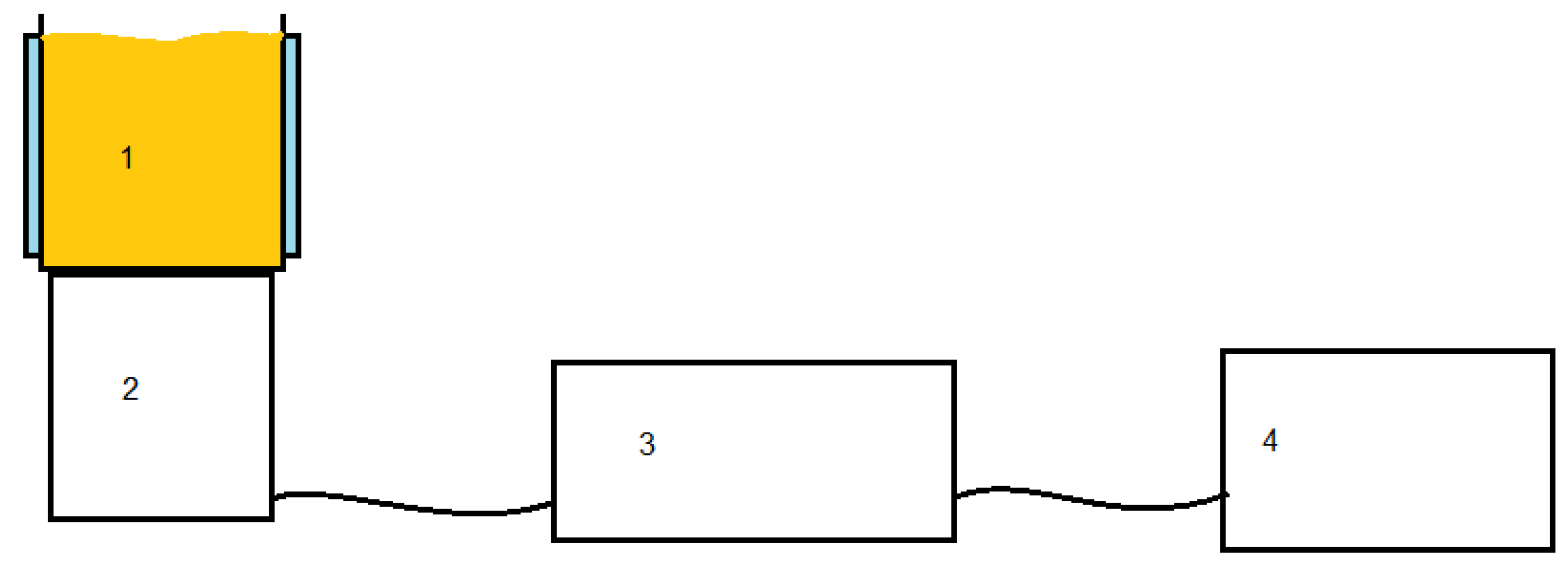
Figure 2.
Influence of the US frequencies on the BPA degradation efficiency.
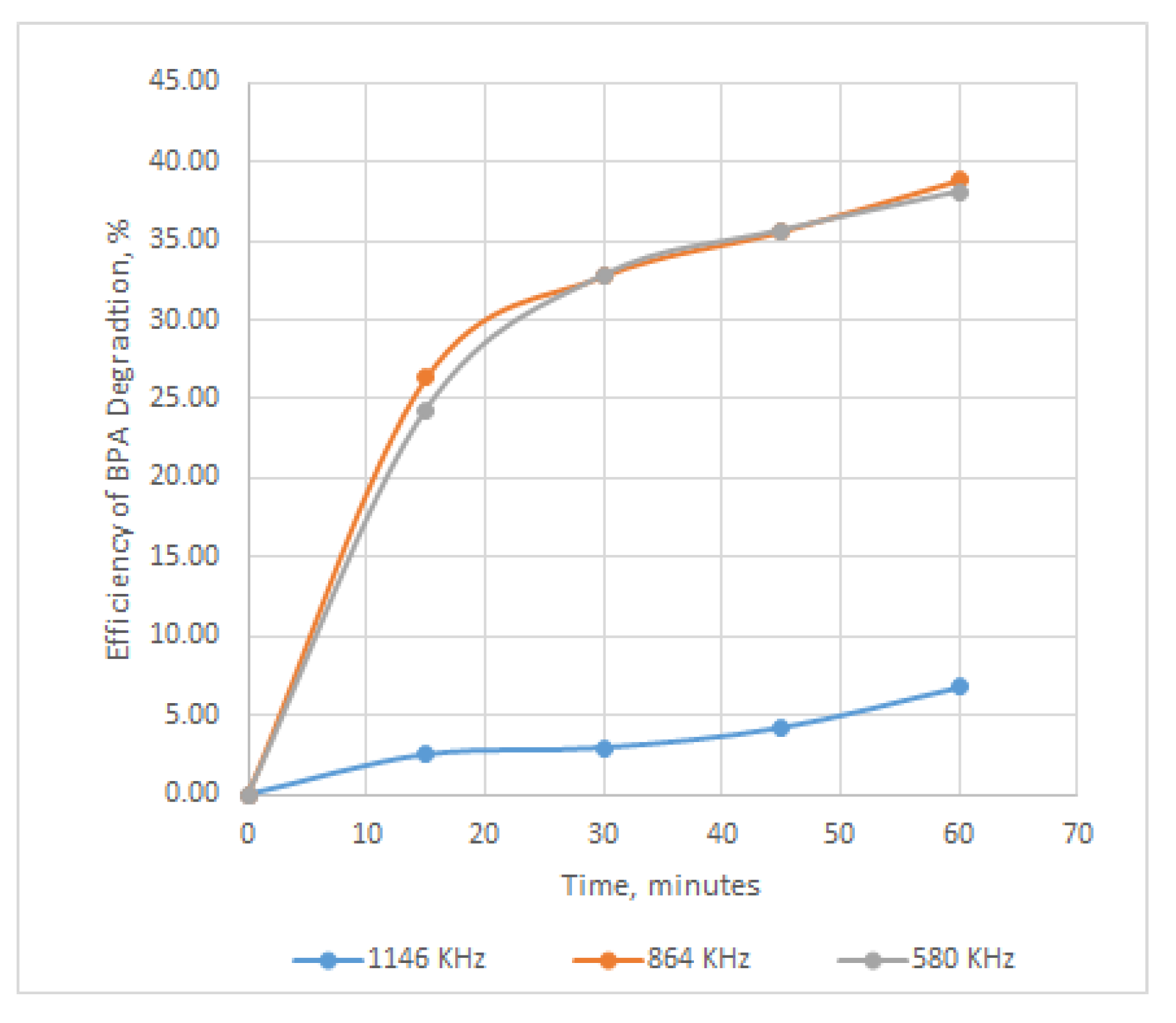
Figure 3.
Concentration chromatograms superimposed at US exposure for frequencies 580 KHz, 864 KHz and 1146 KHz after 0’, 15’, 30’ 45‘and 60‘.
Figure 3.
Concentration chromatograms superimposed at US exposure for frequencies 580 KHz, 864 KHz and 1146 KHz after 0’, 15’, 30’ 45‘and 60‘.
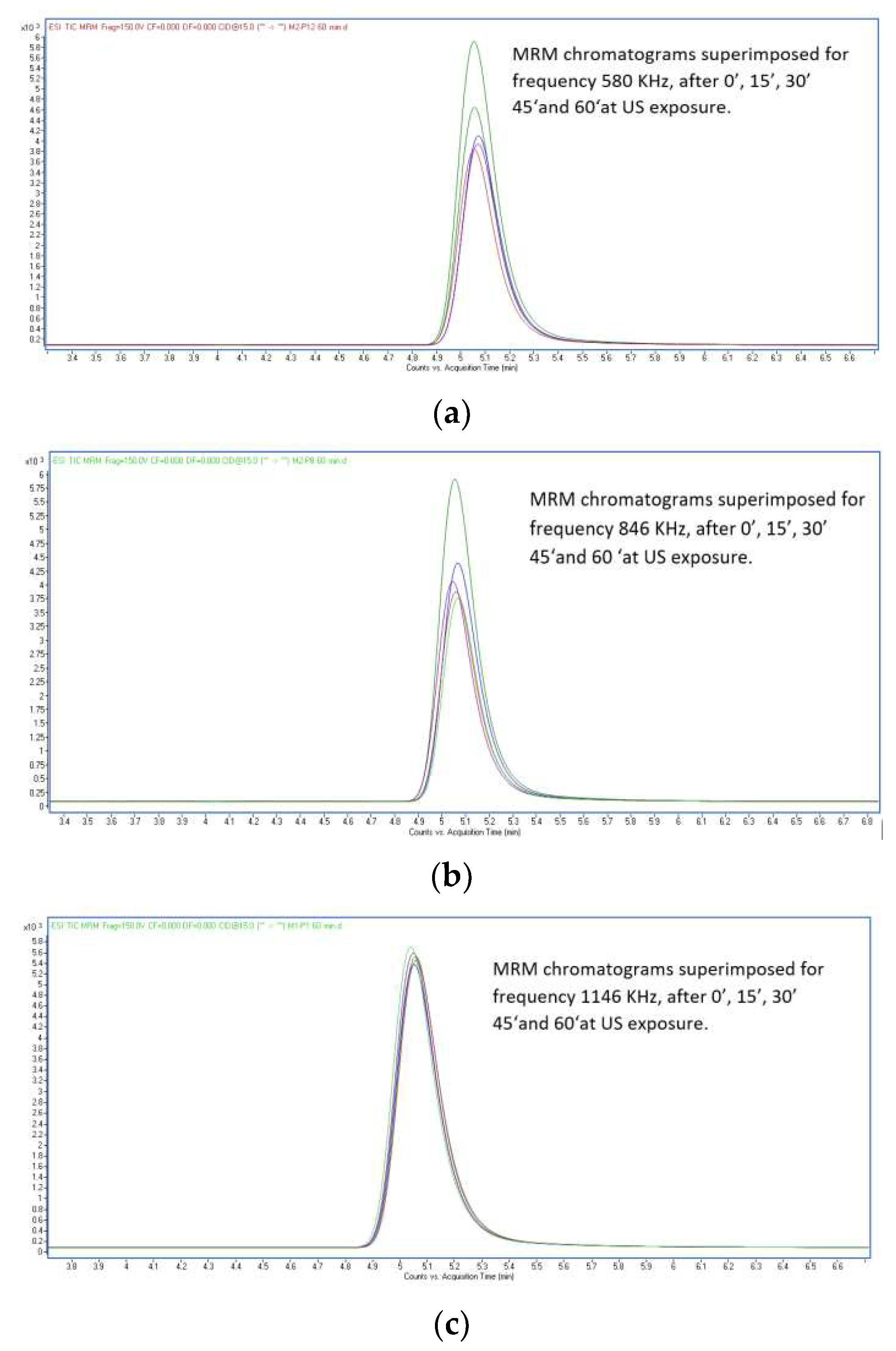
Figure 4.
The proposal pathway to BPA degradation using US at frequencies of 580 KHz and 864 KHz, for an exposure of 60 minutes.
Figure 4.
The proposal pathway to BPA degradation using US at frequencies of 580 KHz and 864 KHz, for an exposure of 60 minutes.
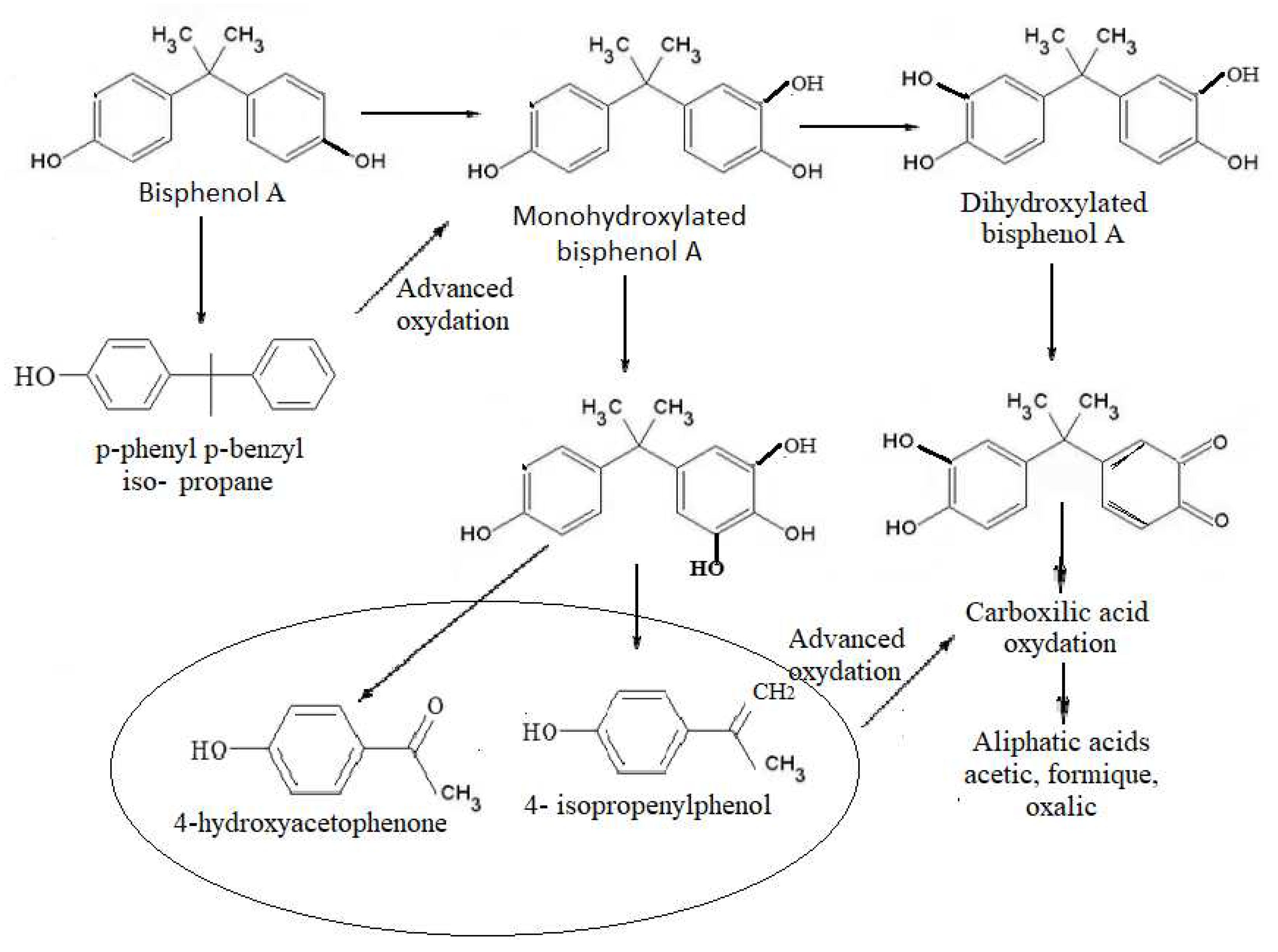
Figure 5.
Efficiency of BPA degradation at US exposure at 580 KHz and 864 KHz, in presence of CCL4,, for 15 minutes.
Figure 5.
Efficiency of BPA degradation at US exposure at 580 KHz and 864 KHz, in presence of CCL4,, for 15 minutes.
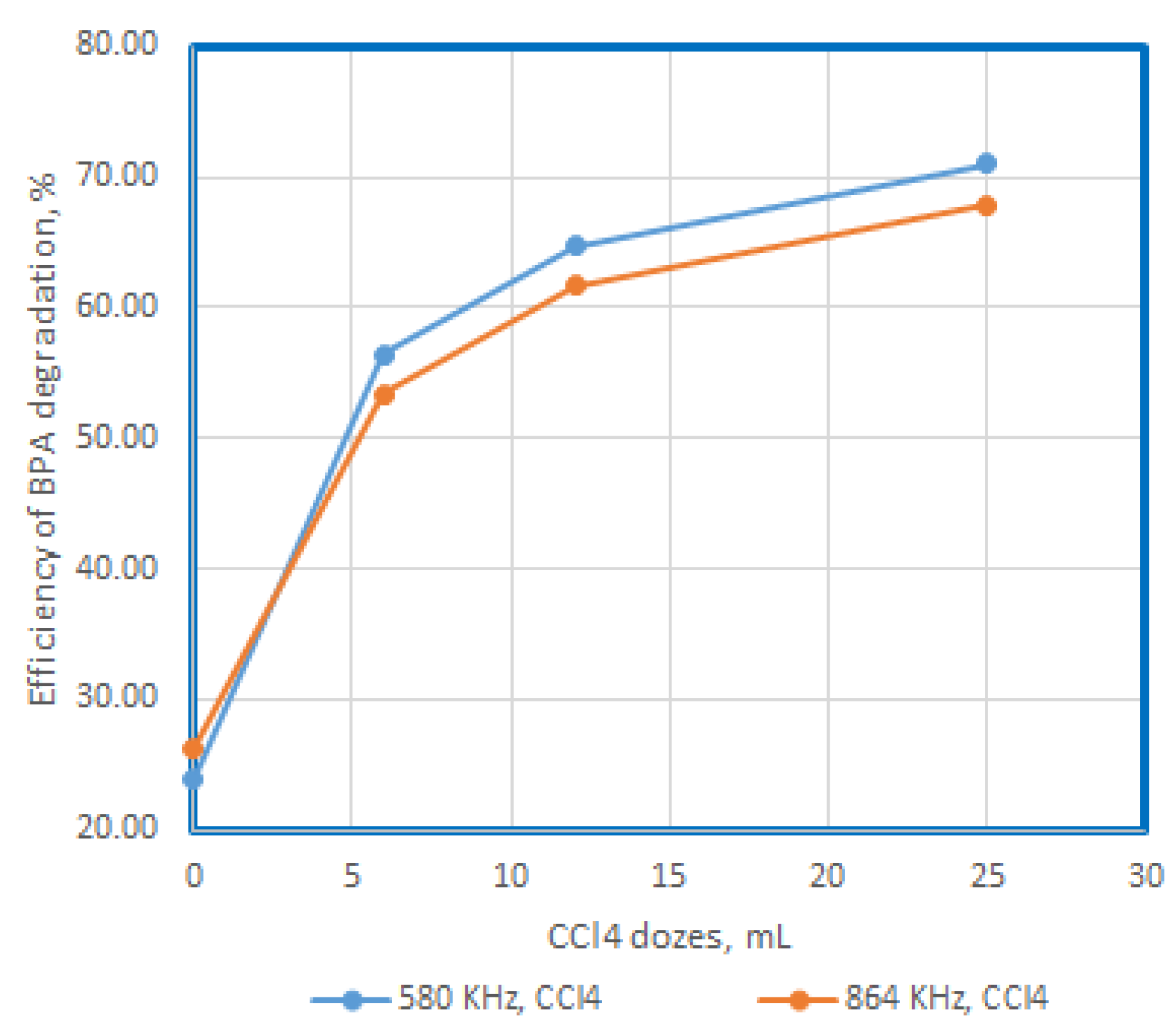
Figure 6.
Efficiency of BPA degradation and mineralization at US exposure with 580 KHz, in presence of CCL4, for 15 minutes .
Figure 6.
Efficiency of BPA degradation and mineralization at US exposure with 580 KHz, in presence of CCL4, for 15 minutes .
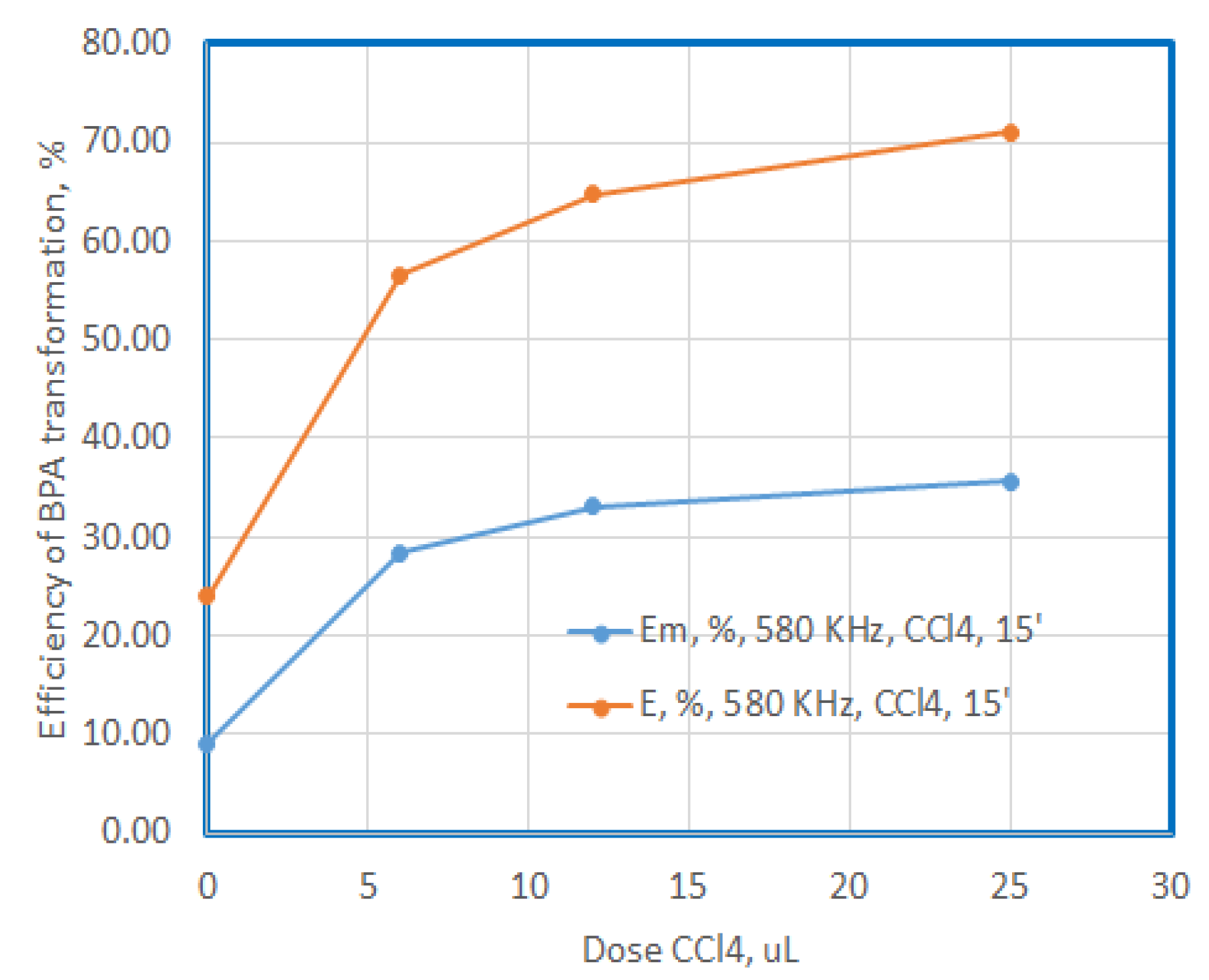
Figure 7.
The proposal pathway to BPA degradation using US at frequencies of 580 KHz and 864 KHz, for an exposure of 15 minutes in presence of CCl4.
Figure 7.
The proposal pathway to BPA degradation using US at frequencies of 580 KHz and 864 KHz, for an exposure of 15 minutes in presence of CCl4.
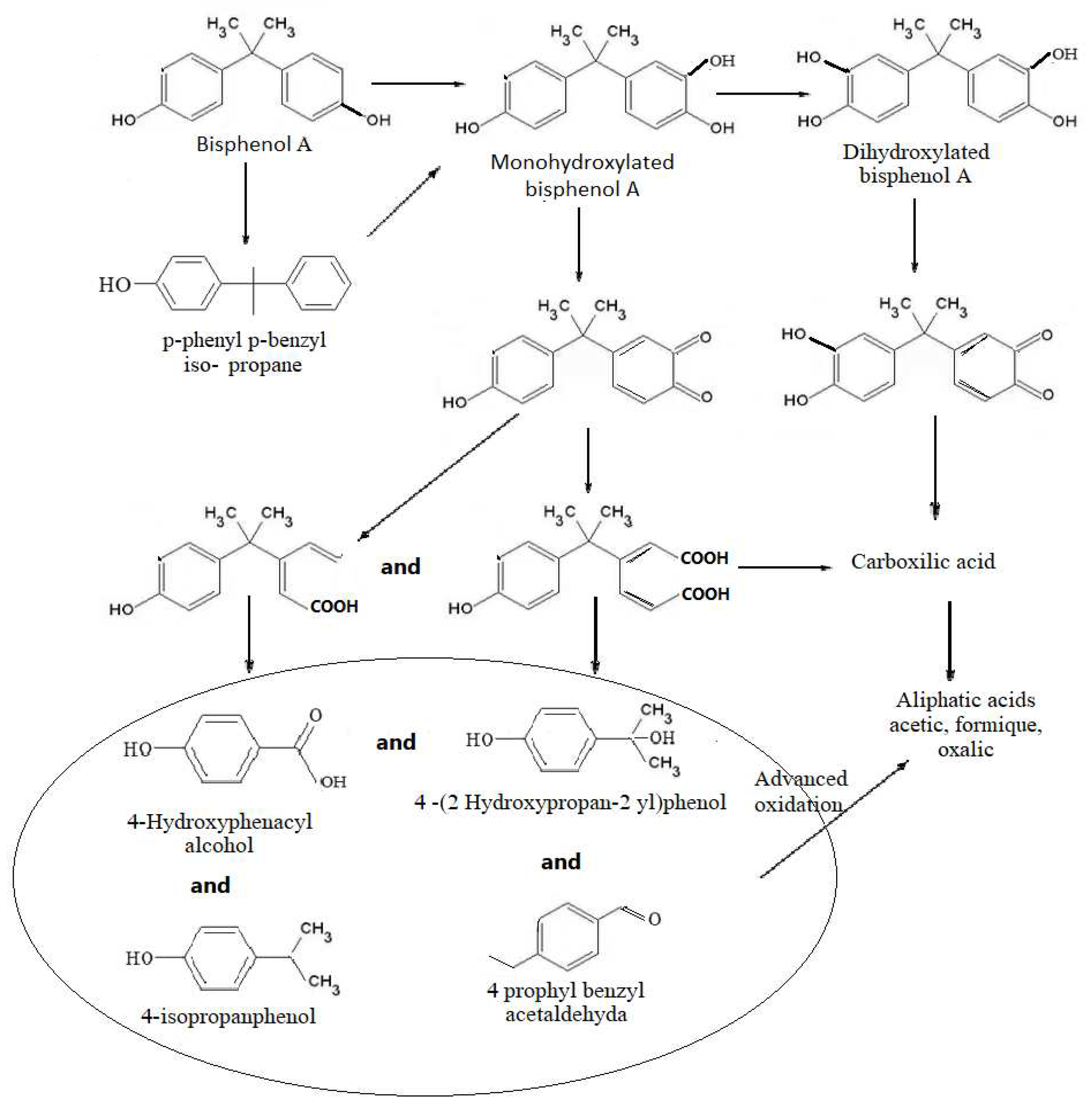
Figure 8.
Efficiency of BPA degradation at US exposure in presence of SF, additional compunds, with a concentration of 0.1 mg/L, in time.
Figure 8.
Efficiency of BPA degradation at US exposure in presence of SF, additional compunds, with a concentration of 0.1 mg/L, in time.
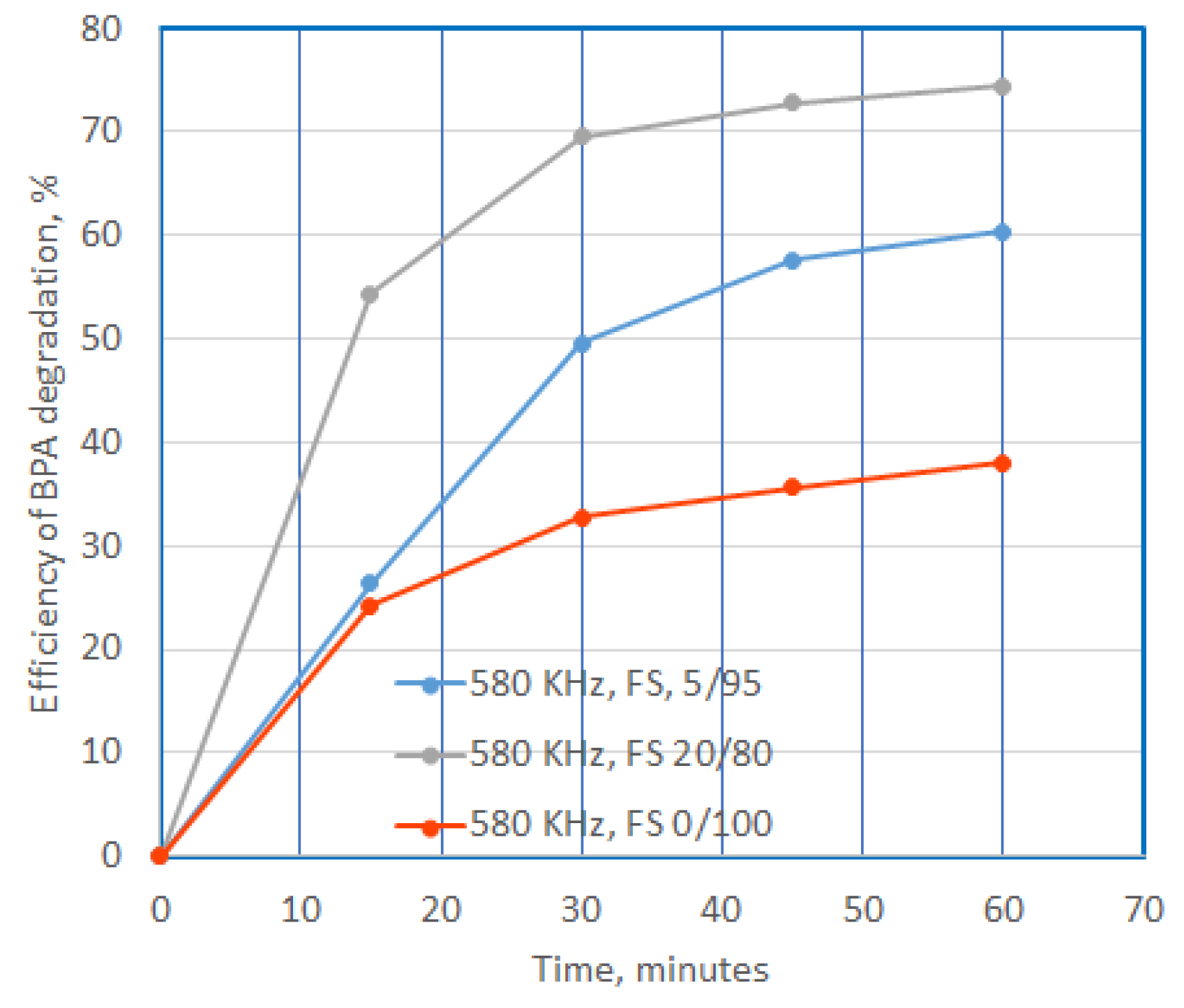
Figure 9.
Efficiency of BPA transformation at US exposure in presence of SF, additional compunds, after 15’.
Figure 9.
Efficiency of BPA transformation at US exposure in presence of SF, additional compunds, after 15’.
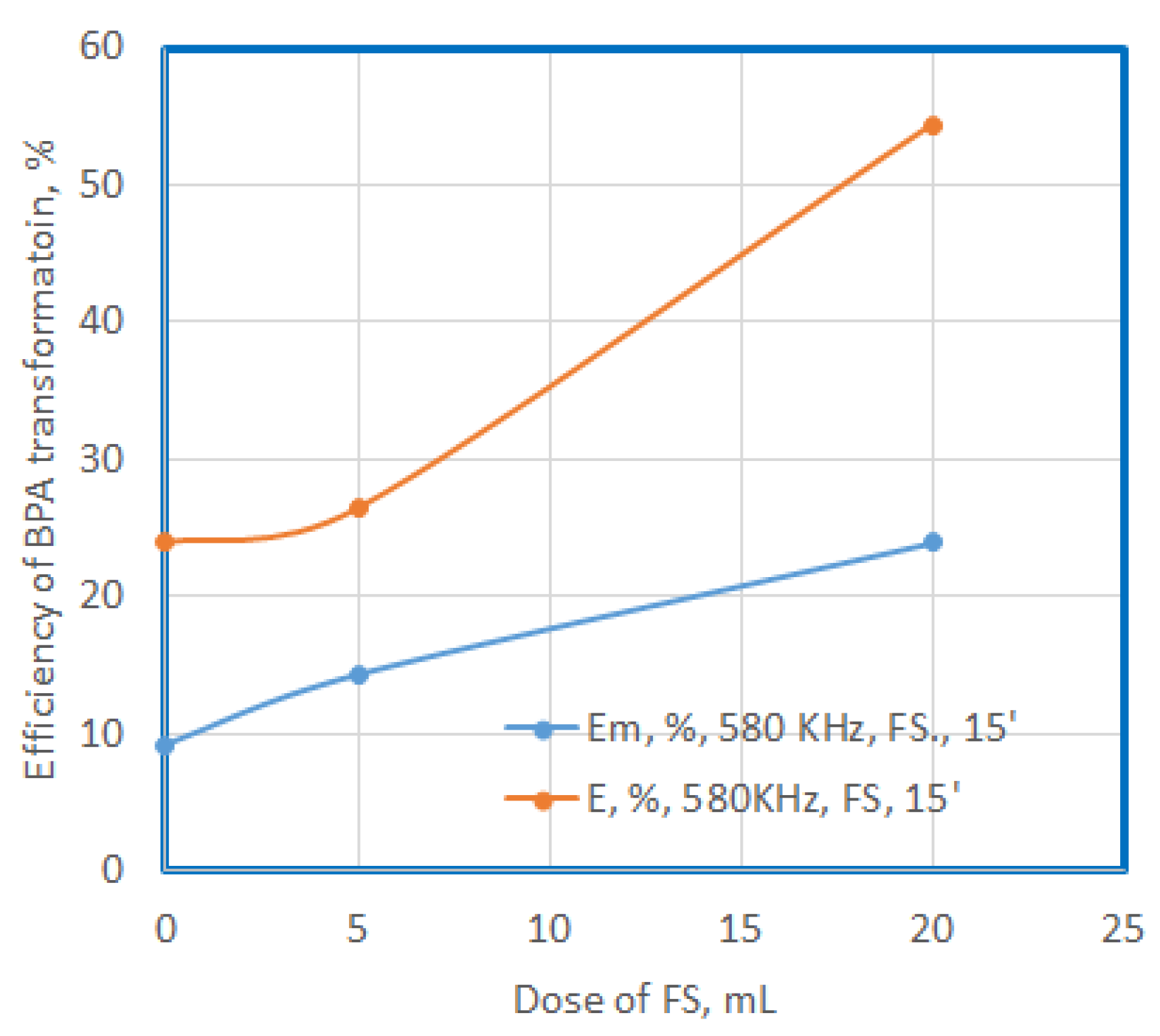
Figure 10.
The proposal pathway to BPA degradation, using US and FeSO4 7H2O with concentration 0.1 mg/L, as additional compunds at different doses, and at frequency of 580 KHz for an exposure of 60 minutes.
Figure 10.
The proposal pathway to BPA degradation, using US and FeSO4 7H2O with concentration 0.1 mg/L, as additional compunds at different doses, and at frequency of 580 KHz for an exposure of 60 minutes.

Figure 11.
Efficiency of BPA degradation at US exposure in presence of EAC, in time.
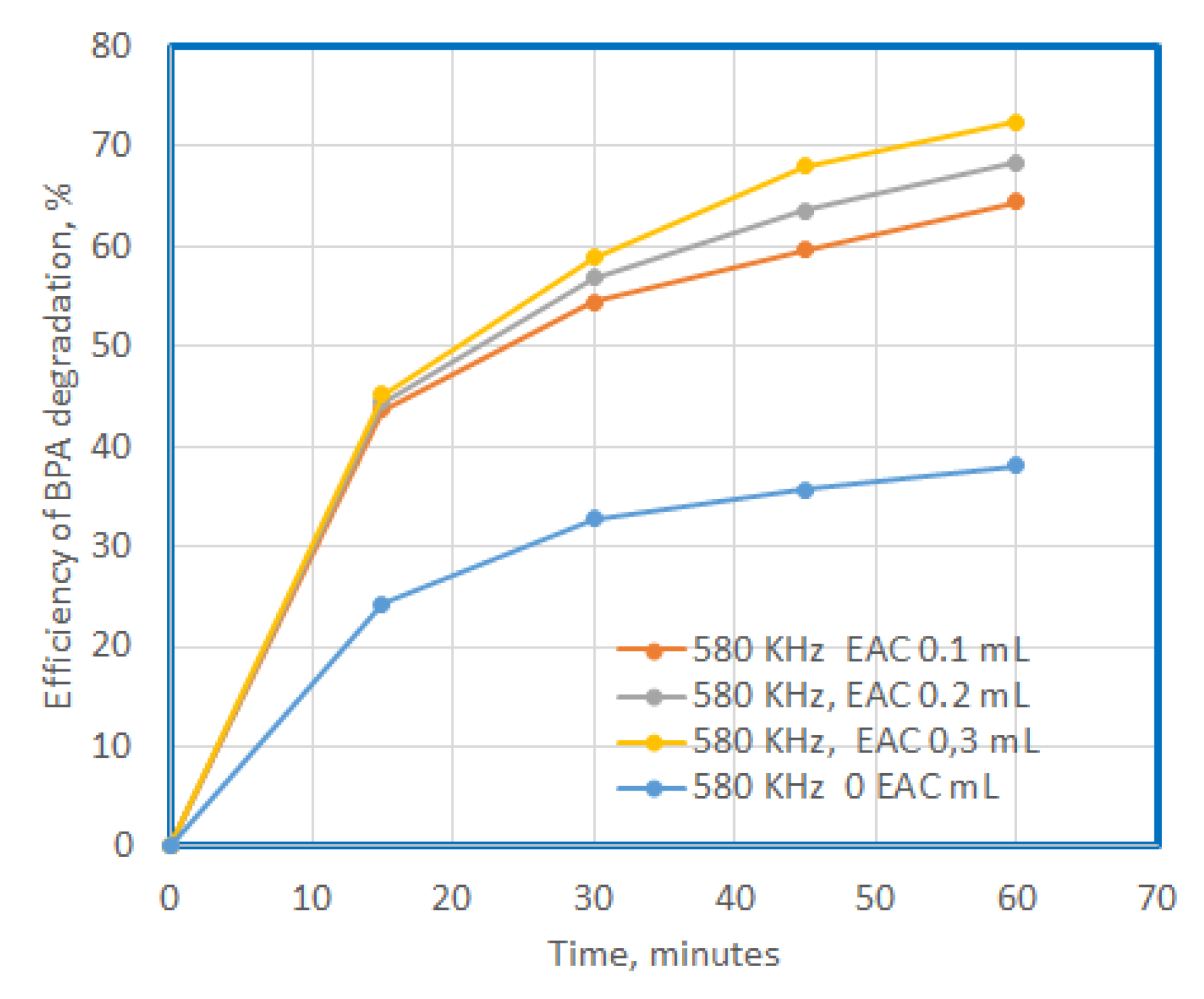
Figure 12.
Efficiency of BPA transformation at US exposure in presence of EAC after 15’ exposure.
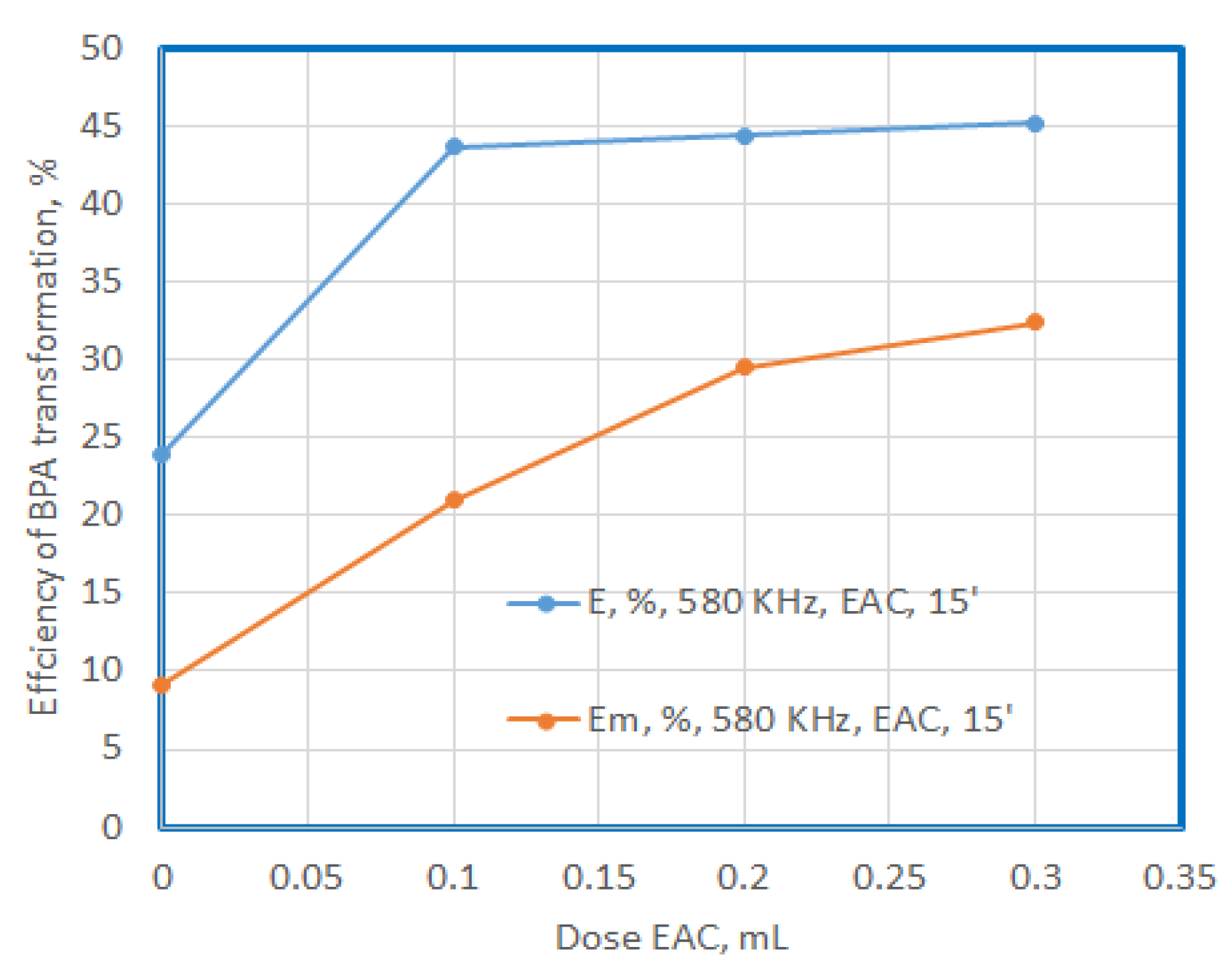
Figure 13.
The proposal pathway to BPA degradation using US and EAC, as additional compunds at different doses and at frequency of 580 KHz for an exposure of 60 minutes.
Figure 13.
The proposal pathway to BPA degradation using US and EAC, as additional compunds at different doses and at frequency of 580 KHz for an exposure of 60 minutes.
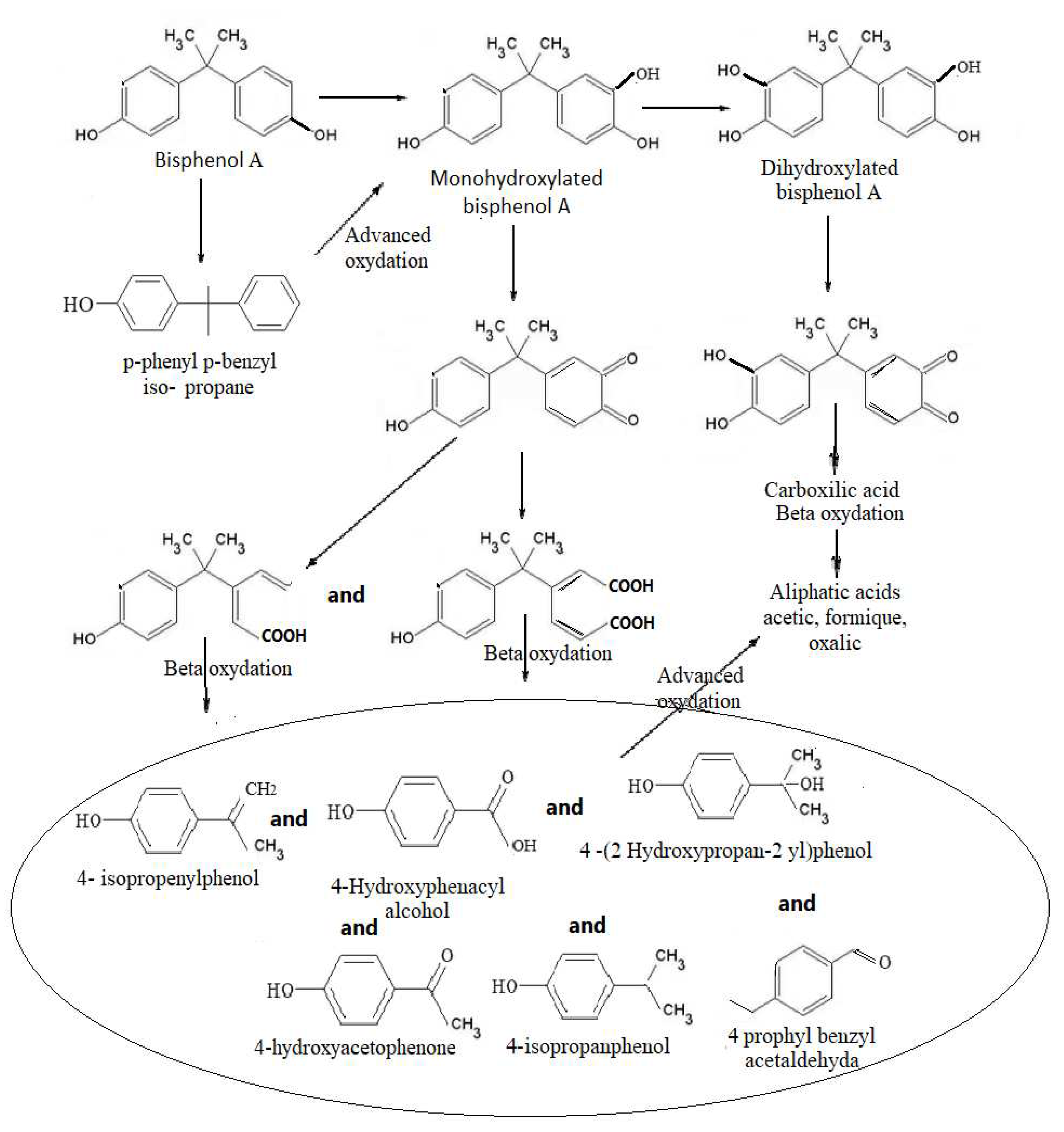
Figure 14.
The comparison between the degradation efficency of BPA at 15 minutes of US exposure and different adittional compounds.
Figure 14.
The comparison between the degradation efficency of BPA at 15 minutes of US exposure and different adittional compounds.
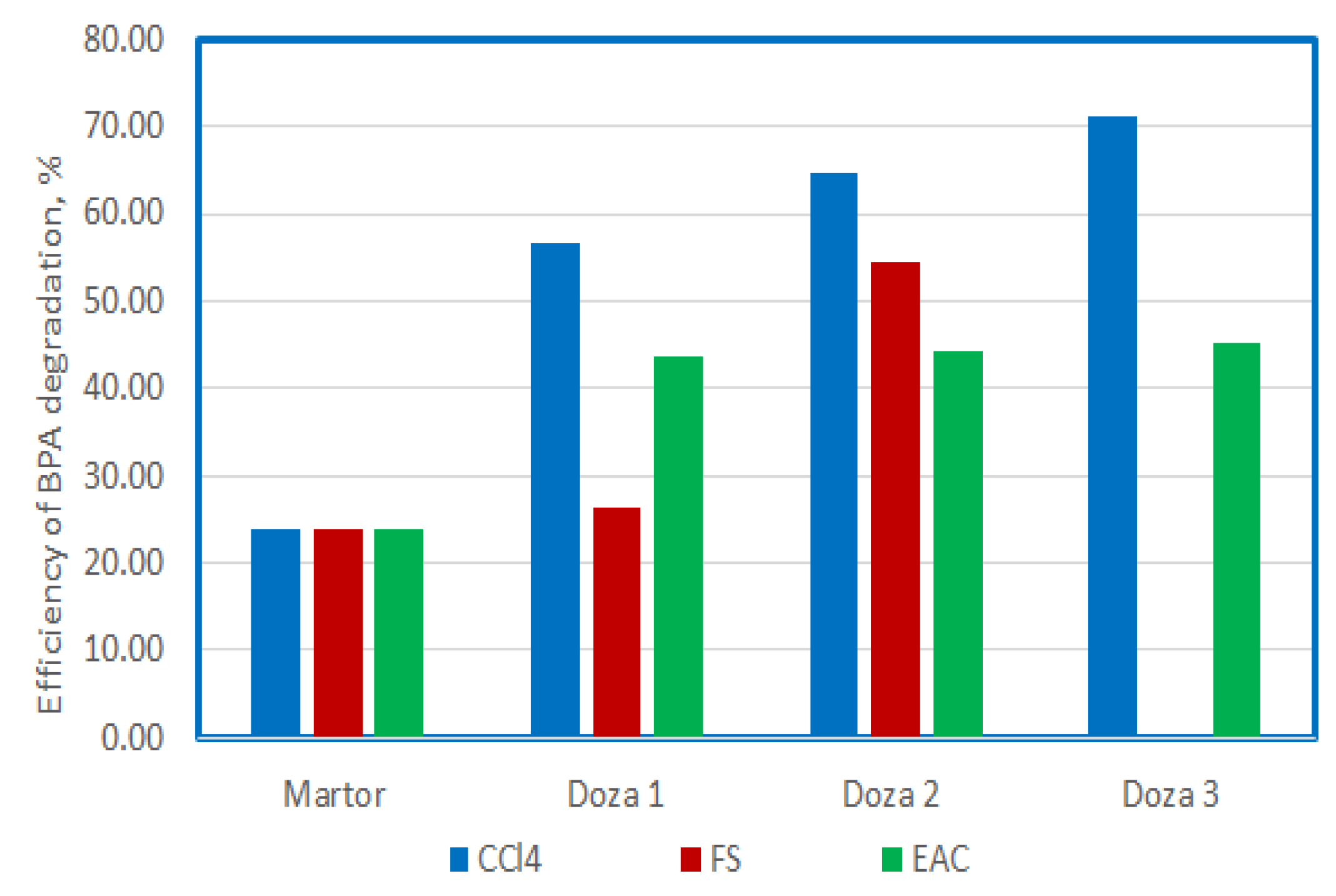
Figure 15.
The comparison between the mineralisation efficency of BPA at 15 minutes of US exposure and different adittional compounds.
Figure 15.
The comparison between the mineralisation efficency of BPA at 15 minutes of US exposure and different adittional compounds.
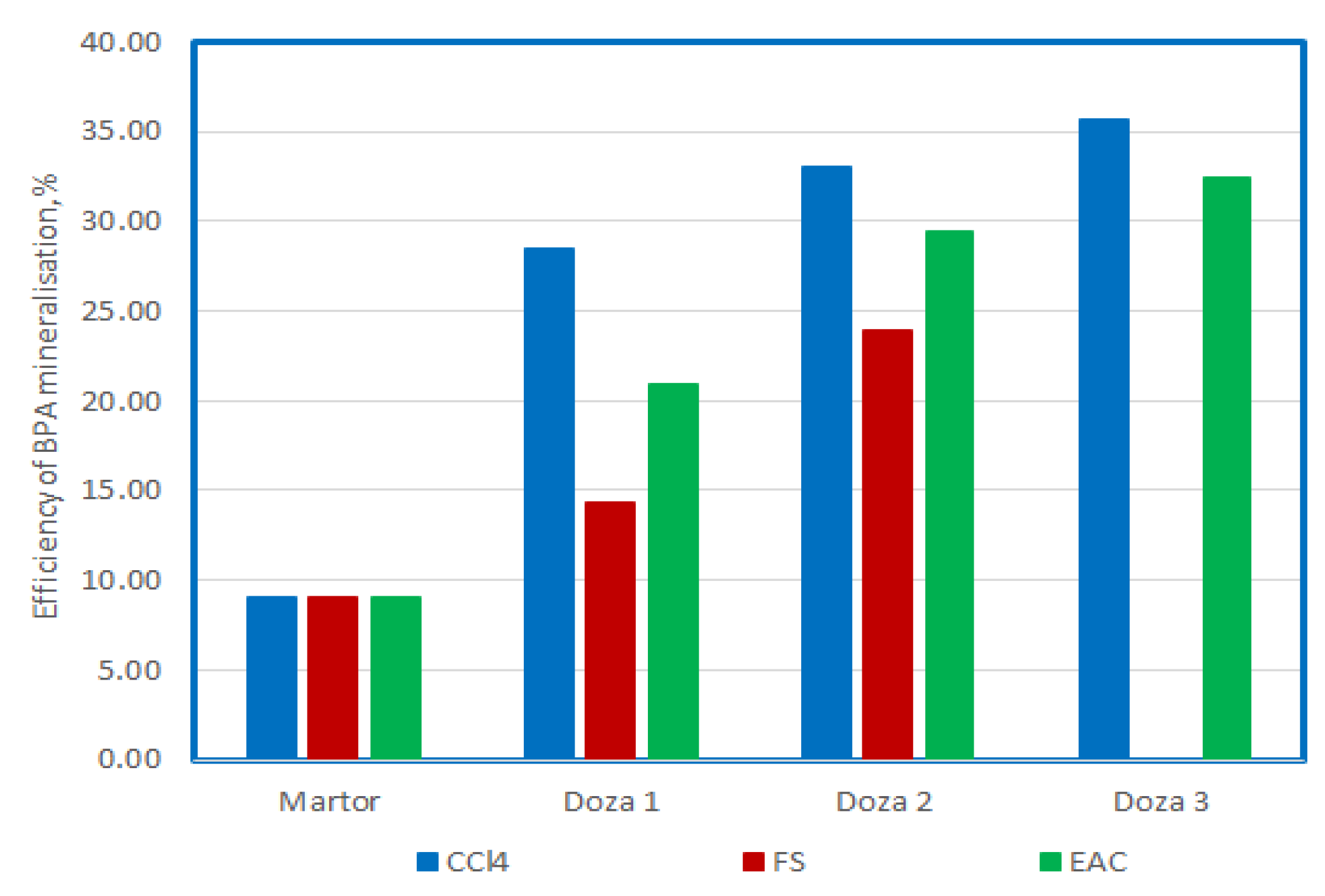
Disclaimer/Publisher’s Note: The statements, opinions and data contained in all publications are solely those of the individual author(s) and contributor(s) and not of MDPI and/or the editor(s). MDPI and/or the editor(s) disclaim responsibility for any injury to people or property resulting from any ideas, methods, instructions or products referred to in the content. |
© 2023 by the authors. Licensee MDPI, Basel, Switzerland. This article is an open access article distributed under the terms and conditions of the Creative Commons Attribution (CC BY) license (https://creativecommons.org/licenses/by/4.0/).
Copyright: This open access article is published under a Creative Commons CC BY 4.0 license, which permit the free download, distribution, and reuse, provided that the author and preprint are cited in any reuse.
Alerts
MDPI Initiatives
Important Links
© 2025 MDPI (Basel, Switzerland) unless otherwise stated







